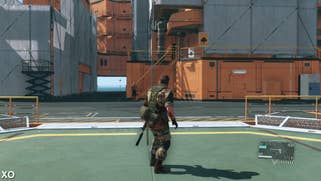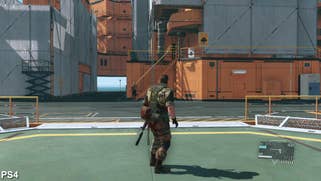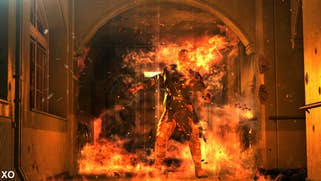1080p60 and beyond: the best PC hardware for Metal Gear Solid 5
How The Phantom Pain on PC improves over console - and the hardware you'll need for the best experience.
Completing the quintet, Kojima Productions ensures a feature-rich PC version of Metal Gear Solid 5 launches on cue - taking pride of place next to well-optimised PlayStation 4 and Xbox One editions. The Fox Engine is let loose here, with PC opening the gates to a very high preset in the graphics menu, while adding 'support' for 4K gameplay. But what tangible benefit do these enhancements bring over console, and what hardware do you need to get the best out of them?
Of course, the game is already optimised well for 60fps on current-gen specs - both PS4 and Xbox One comfortably handing in a gorgeous open-world setting with only a few rough edges. Texture filtering quality falls short, and shadows can appear coarse, but it's a superb showing for Fox Engine in every other sense. Consoles hit a sweet spot in performance and visuals in this regard, and on PC, this close optimisation effort means we can strike a satisfying level of performance even on budget setups.
Much of this hangs on The Phantom Pain's default graphics setting. Running at 1920x1080 with this mode selected, visuals are near identical to playing the game on PS4, and most enthusiast-level GPUs get solid frame-rates straight out of the box. This mode consists of high settings for textures, lighting, ambient occlusion and post-processing - while texture filtering and shadows are left at just medium (perhaps telling of PS4 and Xbox One's shortfalls here). All this combines to give a great-looking game, though there a couple of further tweaks needed to perfectly match the console look.
Therein lie some surprises. Model detail on PS4 and Xbox One runs at a lower quality than PC's low setting. Contrary to its labeling, this affects the draw distance for geometry and foliage across open areas - and surprisingly, the current-gen standard can't be matched on any of the PC's four preset levels here. Up close, all details draw in at the same level of density, but on console they simply fade in at a closer range. On the plus side, current-gen platforms have volumetric clouds effect enabled (which isn't enabled on default mode) - meaning clouds move dynamically across the sky on each, casting shadows across the ground below. For Xbox One, this marks an upgrade over its Ground Zeroes incarnation, where this effect was absent.
Meanwhile, comparing PS4 and Xbox One to the PC's maximum settings reveals several interesting visual boosts. In summary, we get high quality anisotropic filtering across the ground, clearing up textures at oblique angles where the consoles' mapping is left blurred. Shadow lines are also smoothed over at PC's very high setting, cutting out all aliasing on long shadows across our test area in Mother Base - while screen space ambient occlusion (SSAO) draws in at a greater range on PC. At very high, ambient occlusion uses the exact same dithered method as PS4 and Xbox One's high setting - the only difference being its rendering distance.
As with Ground Zeroes, PC at max settings gives us a more refined, bokeh depth of field in cut-scenes - as altered through its post-processing setting, where console rests at the high preset. Lighting also benefits from PC's top-grade treatment with the introduction of screen-space reflections, a subtle effect that has Big Boss cast reflections on wet surfaces. It's hard to catch in daylight, but the spotlights around Mother Base at night bring it out well, with high contrast points mirrored on nearby walls - while consoles go without.
These are all great extras that build on the console versions' solid core, though PS4 and Xbox One still do themselves proud in comparison. But what kind of PC does it take to actually hit this high bar of quality? Fortunately, The Phantom Pain is relatively light on CPU use, and even our Haswell Core i3 processor doesn't get close to hitting full capacity in its most intensive scenes. Memory wise, as always we recommend 8GB of RAM in your PC, while your graphics card should have a minimum of 2GB of GDDR5 for 1080p gameplay. In terms of scaling through Metal Gear Solid 5's higher-end quality presets, virtually all of the focus is on the GPU side, and in testing a gamut of cards, this puts into focus how scalable the Fox Engine is.
To work from the ground upwards, Nvidia's GTX 750 Ti is still a front-runner for the budget-orientated PC gamer, with prices recently cut to £90. However, at default settings, it's clear that stock clocks don't quite cut it, with the card hitting 32fps on alpha-heavy explosions in battle, and 50fps for regular shoot-outs. The fix is simple however: raising the memory clock by 400MHz (in our case via MSI's Afterburner utility) we clear the bottleneck entirely, and can hit a perfect 60fps - without even touching the core clock. There's headroom to switch volumetric clouds and superior texture filtering on too, and the default preset also qualifies it for broader draw distances than on console. So with minimal tweaking, our budget gaming PC is actually capable of handing in a more refined version of the game at 1080p, inching ahead of the PlayStation 4 version.
But what does it take to hit maximum settings at 1080p? Inevitably the 750 Ti doesn't make the grade here, forcing us to bump the budget to around £120-140. Based on our testing in this category, AMD's R7 370 and Nvidia's GTX 950 (25-45 per cent more powerful than the 750 Ti depending on the model) each still struggle to tackle the game at very high. Even by raising the memory clock on the Nvidia card by 400MHz, plus 160MHz on its core clock, the 60fps target is still out of reach. In fact, an overclocked GTX 950 gets us to around 50fps when approaching busy enemy encampments, and only by dropping ambient occlusion and post effects by a notch do we reach a consistent 60Hz refresh.




















Of course, both the R7 370 and GTX 950 handle default settings easily, but in the pursuit of maxed-out settings at 1080p, we have to go one better. Sadly, the slightly pricier GTX 960 shows similar drops to 55fps when maxed, meaning our only option is to jump all the way to the GTX 970. This raises the budget significantly to £220-250, but ultimately, 1080p at maximum settings is very doable on this card's stock clocks, with no compromises needed. However, it must be said that for the sake of keeping ambient occlusion and post effects at top quality, the budget gap between the GTX 960 and 970 is huge, and the visual gains are relatively small.
But what of The Phantom Pain's support for resolutions such as 1440p? The GTX 970 is an easy lock for 1440p at default settings, but it shows its limits when maxed out on this resolution - a likewise scenario for the AMD equivalent, the R9 390. For reaching the target 60fps, a costly GTX 980 Ti is required, and even then dropping post-processing to 'high' is needed to smooth off the edges around a 60fps target. The hit to visuals isn't too great, and those with 2560x1440 displays have plenty of flexibility in the options to adjust.
As far as 4K (or 3840x2160) gaming is concerned, the GTX 980 Ti is once again the best bet. Running everything at maximum settings puts the performance of general open-world gameplay at around 40-45fps, which makes the game's 30fps cap a temptation. However, by dropping effects, post-processing and ambient occlusion options down a notch to the high preset, you regain a smooth 60fps at 4K without any issue. It's a seamless ultra HD experience during missions this way, and only brief drops in the prologue's alpha-heavy cut-scenes interrupt it.




















Metal Gear Solid 5: The Phantom Pain on PC - the Digital Foundry verdict
Just like Ground Zeroes before it, Metal Gear Solid 5: The Phantom Pain is one of the best-optimised titles on PC, and a superb way to experience Kojima's swansong to the series. It suits a wide range of setups - with even a Core i3 budget PC with a GTX 750 Ti capable of matching and even exceeding the PS4 experience in certain areas. It's a scalable game too - at its highest presets at ultra HD, it can even give the GTX 980 Ti and Titan X a run for their money - but ultimately, a 1080p target is very achievable on just about any enthusiast gaming hardware setup.
And crucially, Kojima Productions gives PC users plenty of options to tinker with its Fox Engine. The lack of support for frame-rates above 60fps is a shame, but everything else is present; from toggles to scale lighting quality and geometry LODs, to adjusting the quality of post-effects. Ultimately, the gains over PS4 and Xbox One are welcome; shadows are cleaned up, texture filtering is much improved, and the draw distance is broadened. However, the core elements are the same up close, and all three versions are highly recommended.
All in all, the Fox Engine once again rises to the challenge on PC, showing us its adaptability in the face of multiple hardware configurations. It's a shame that the only upcoming title to use this technology is Pro Evolution Soccer 2016 - and with Kojima Productions disbanded, we're unlikely to see the speculated open-world remake of the Metal Gear Solid using the engine. Even so, let's hope Metal Gear Solid 5's success here spurs Konami to return to more AAA projects in this vein - and that this engine forms the basis of its efforts.










